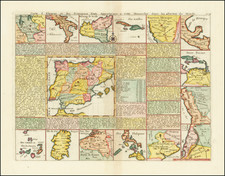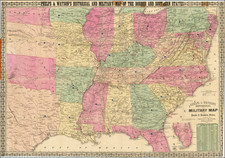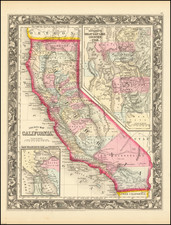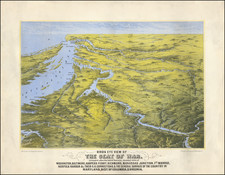The First Map to Fully Illustrate the Results of the Louisiana Purchase
Wilkinson's map, issued August 12, 1804, is among the rarest and most interesting maps of North America, and includes one of the earliest depictions of the Louisiana Territory and a late depiction of the proposed State of Franklin.
The map frames the North American continent from Pacific to Atlantic and from the Great Slave Lake to the tip of Baja California. The pink area covering what is now Canada shows British possessions, while the yellow indicates Spanish colonies. Sandwiched between the two is the huge central swath of land known as Louisiana and it is listed as a US possession according to the table in the lower right corner.
The table also offers other insights into US history. For example, Vermont is listed as an "Allied State", indicating that it was the first state to be admitted to the union after the original thirteen colonies in 1791 and after governing itself autonomously for fourteen years. The next states to join the US were Kentucky (1792), Tennessee (1796), and Ohio (1803). The latter is shown as the Western Territory on the map. All three are listed in the map's table as "Subject States" along with Main[e], Indiana, and Franklinia.
The map is covered in staggering detail with settlements, geographic features, and information about the indigenous peoples that lived across the continent. Wilkinson follows Arrowsmith's Map Exhibiting all the New Discoveries in the Interior Parts of North America (1802), particularly in the Rocky Mountain region and the Oregon River area. However, a comparison of the number and variety of place names show that Wilkinson also used other sources. Beyond Arrowsmith, there are also narrative notes revealing sources such as the French cartographer Guillaume Delisle, George Vancouver's accounts of the Northwest Coast from his voyage in the 1790s, and David Thompson's surveys of the Upper Missouri River on behalf of the North West Company in 1798.
Lahontan
One source that is mentioned several times by Wilkinson is Lahontan, or Louis-Armand de Lom d'Arce, Baron de Lahontan. Lahontan was a member of the aristocracy and an army officer serving in New France. In addition to, or instead of, his military duties he explored much of the upper Mississippi River Valley. During King William's War, Lahontan deserted his post and fled to Amsterdam and then Spain, from where he penned his memoirs which were intended to tell the English how to invade New France. Back in Amsterdam, he also wrote the three travel accounts for which he is still famous.
Wilkinson clearly valued Lahontan's works, but he also reinterpreted them. For example, Wilkinson includes the "R. Morte or R. Longue according to Lahontan." Many scholars now believe Lahontan's R. Longue to be the Missouri River. However, Wilkinson has placed it farther south; it appears to be what is now called the Platte River. Lahontan is also mentioned with regard to the Pearl Shell Lake, "according to Lahontan & from Indian report salt water." The lake is in roughly the same position as the Great Salt Lake.
Near to the Pearl Shell, or Great Salt, Lake is "Quivira or Moozemlek (of Lahontan) Indians much civilized having 100 Towns, and Sailing with large Vessels." This label is an amalgam of information from Lahontan and other sources. Quivira refers to the Seven Cities of Gold sought by the Spanish explorer Francisco Vasquez de Coronado in 1541. In 1539, Coronado wandered over what today is Arizona and New Mexico, eventually heading to what is now Kansas to find the supposedly rich city of Quivira. Although he never found the cities or the gold, the name stuck on maps of southwest North America, wandering from east to west.
Louisiana Territory
Wilkinson's map is the first to show the entire Louisiana Territory as part of the United States. It is both shown on the map and is listed in the table as, "Province, Ceded by France 30 Apr. 1803} Louisiana." It is true that Bradley's Map of The United States dated June 2, 1804 is the first map to reference the cession of Louisiana, "The French call the country West of Conecuh River Louisiana and have ceded it to the United States." However, unlike the Wilkinson map, the Bradley map shows only a small portion of the Louisiana Territory, the part just west of the Mississippi River.
The State of Franklin
Franklinia is shown between Tennessee and North Carolina. Also known as the State of Franklin, the entity was an autonomous region that never gained recognition from the US government. The "State" occupied land ceded to Congress to pay off North Carolina's Revolutionary War debts. On August 23, 1784, the territory succeeded from North Carolina and then petitioned for statehood in May 1785. Congress denied their petition. After only four and a half years the state was absorbed back into North Carolina in 1788. In 1790, the land was designated as part of the new Southwest Territory. Today, it is part of eastern Tennessee. The inclusion of the state on this later map shows the power the upstart territory had in geographic and political imagination as far away as London.
The mapmakers
Robert Wilkinson (1752 ca.-1825) was a printer, publisher, mapseller and mapmaker. After John Bowles died in 1779, Wilkinson took over his stock and shop in Cornhill. He continued in business until his death in 1825, when his plates and stock were auctioned. Throughout his career he made profits from reprinting Bowles' work, but also by creating his own maps in partnership with an engraver. Early on he worked with the artist Louis Stanislas de la Rochette. Later, Wilkinson worked with Ebenezer Bourne, who engraved this map. Wilkinson worked in two shops, first at 58 Cornhill, where the 1804 map is addressed, and later at 125 Fenchurch Street, where the later state of the map is addressed.
Ebenezer Bourne (1763 ca.-1838) was a skilled engraver who worked with several map sellers including William Faden and John Fairburn, but his most fruitful partnership was with Wilkinson. Originally apprenticed in the Tinplate Workers, he began work as the engraver for the Ordnance Survey in 1802.
Rarity
A Glasgow copy of the 1804 Wilkinson map appeared in 1811. Another edition of the map was released in 1824 with only Wilkinson's address and the year in the title altered. There was also another reissue in 1826, a year after Wilkinson's death.
In his otherwise erudite work, Mapping the Transmississippi West, Carl I. Wheat calls the 1824 edition of the work, misdated to 1823, "the strangest, most atavistic map of North America" (vol II, 77). Wheat, unaware of the rare first edition of 1804, was describing the seemingly antiquated qualities of the map. In reality, he was looking at a second edition of one of the most spectacular, and accurate, large-format maps of North America issued prior to the maps by the likes of Humboldt, Lewis & Clark, Pike, and Stephen Long.
The map is without question an important cartographic and historical gem, and one that has gone largely unappreciated to date due to its rarity. There are only a handful of institutional copies. Until 2008 (Sothebys), no copy of the map had appeared at auction since the Streeter Sale of 1966-9.
Ebenezer Bourne (1763 ca.-1838) was a skilled engraver who worked with several map sellers including William Faden and John Fairburn, but his most fruitful partnership was with Robert Wilkinson. Originally apprenticed in the Tinplate Workers, he began work as the engraver for the Ordnance Survey in 1802.










![A New Mapp of America Septentrionale . . . 1669 [California shown as an island]](https://storage.googleapis.com/raremaps/img/small/94304.jpg)


![[ Extensively Annotated By An Early Owner ] Georgia from the latest Authorities](https://storage.googleapis.com/raremaps/img/small/100877.jpg)
